Bacteriological study of the cerebrospinal fluid(CSF) of children with meningitis in Baghdad
Main Article Content
Abstract
The study included 92 samples of CSF taken from children aged 1day to 10 years with meningitis. The study was conducted in the hospitals of Medical City in Baghdad. The samples were obtained by a specialized staff. Conventional direct Gram stain and culture tests were performed. The study sample were categorized into three group a (1day to 2 years), (2 to 6 years) and (6 to 10 years).
The results of the culture test showed that 62 samples out of 92 samples were free of bacteria while 30 samples contained bacteria (43% ). Among the positive culture group , 43% were gram positive bacteria and (57%) were Gram negative bacteria.
Escherichia coli (43.4 %) was the predominant organism. The second bacterial agent is Staphylococcus aureus (20%) followed by Streptococcus pneumonia (13, 3%). The fourth bacterial isolates were Streptococcus agalactia (10%) and Neisseria meningitidis (10 %).The fifth bacterial agent was Klebsiella pneumonia (3.3%).
The most common age group for bacterial meningitis was the first age group (1 to 2 years old) with Escherichia coli being the main bacterium (40%).
Article Details

This work is licensed under a Creative Commons Attribution 4.0 International License.
Tikrit Journal of Pure Science is licensed under the Creative Commons Attribution 4.0 International License, which allows users to copy, create extracts, abstracts, and new works from the article, alter and revise the article, and make commercial use of the article (including reuse and/or resale of the article by commercial entities), provided the user gives appropriate credit (with a link to the formal publication through the relevant DOI), provides a link to the license, indicates if changes were made, and the licensor is not represented as endorsing the use made of the work. The authors hold the copyright for their published work on the Tikrit J. Pure Sci. website, while Tikrit J. Pure Sci. is responsible for appreciate citation of their work, which is released under CC-BY-4.0, enabling the unrestricted use, distribution, and reproduction of an article in any medium, provided that the original work is properly cited.
References
1- Erdem, I.; Hakan, T.; Ceran, N. and et al. (2008). Clinical features laboratory data, management and the risk factors that affect the mortality in patients with postoperative meningitis. J. Neurol India
2 -Pagana. K. D; pagana. T. J (2010)" Mosbys manual of diagnostic and laboratory tests 5thed " Pennsylvania
3- Carbonnelle, E. (2009). Laboratory diagnosis of bacterial meningitis: usefulness of various tests for the determination of the etiological agent. J. Med. Mal. Infect
4- Brouwer, MC; Tunkel, AR; and Van de Beek, D.(2010).Epidemiology diagnosis, and Antimicrobial Treatment of Acute Bacterial Meningitis, American Society for Microbiology .Clinical Microbiology Reviews. J.ASM.org
5-Tunkel, AR. (2010). "Approach to the Patient with Central Nervous System Infection. In: Principles and Practice of Infectious Diseases". 7th ed., Mandell GL, Bennett JE, Dolin R. (eds.). Churchill Livingstone Elsevier, Philadelphia.
6-Mein J.; Lum G. (1999) Cerebrospinal fluid, bacterial antigen detection tests offer no advantage over Gram’s stain in diagnosis of bacterial meningitis. Pathology. 7. Kala Y. (2014) Study of Bacterial Meningitis in Children below 5 Years with Comparative Evaluation of Gram Staining, Culture and Bacterial Antigen Detection.Clinical Diagnostic research. 2014 Apr; 8(4) 8. Chinchankar N, Mane M, Bhave S, Bapat S, Bavdekar A, Pandit A. Diagnosis and outcome of Acute Bacterial Meningitis in early childhood. Indian Paediatrics. 2002;39:914–21. 9. SWARNALI J, GAUTAM KUMAR JOARDAR, PANKAJ KUMAR MANDAL. Meningitis in Children: A Study in Medical College & Hospital, Kolkata. BANGLADESH J CHILD HEALTH 2012; VOL 36 (1): 20-25. 10. Ceyhan M, Yildirim I, Balmer P, Borrow R, Dikici B, Turgut M, et al. A prospective study of etiology of childhood acute bacterial meningitis, Turkey. Emerg Infect Dis. 2008;14:1089–96.
